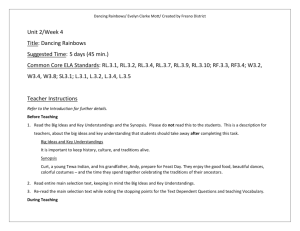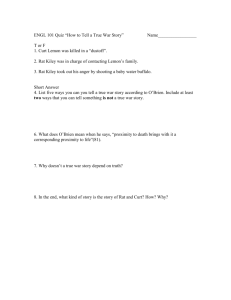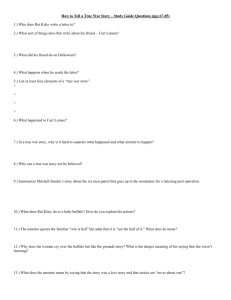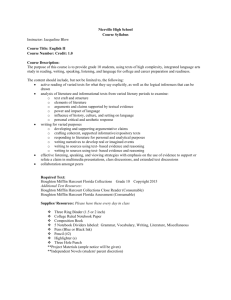hmh_medallion_3_dancing_rainbows
advertisement
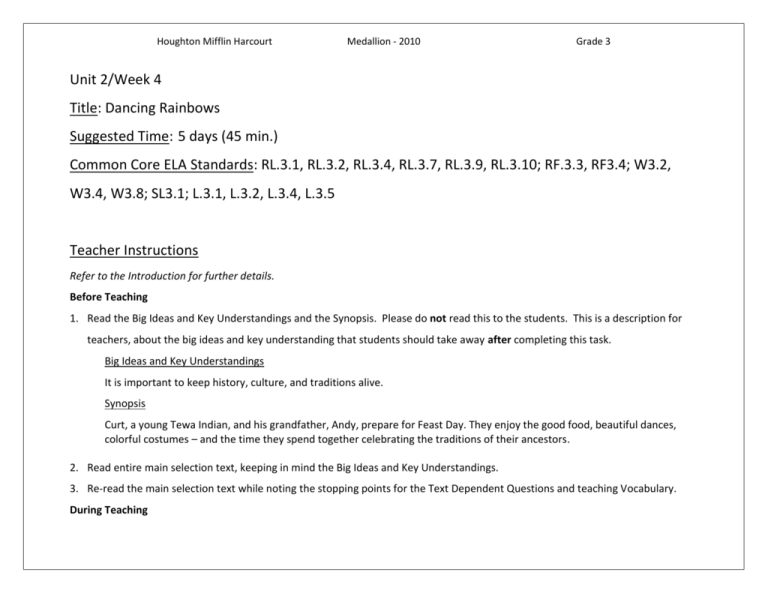
Houghton Mifflin Harcourt Medallion - 2010 Grade 3 Unit 2/Week 4 Title: Dancing Rainbows Suggested Time: 5 days (45 min.) Common Core ELA Standards: RL.3.1, RL.3.2, RL.3.4, RL.3.7, RL.3.9, RL.3.10; RF.3.3, RF3.4; W3.2, W3.4, W3.8; SL3.1; L.3.1, L.3.2, L.3.4, L.3.5 Teacher Instructions Refer to the Introduction for further details. Before Teaching 1. Read the Big Ideas and Key Understandings and the Synopsis. Please do not read this to the students. This is a description for teachers, about the big ideas and key understanding that students should take away after completing this task. Big Ideas and Key Understandings It is important to keep history, culture, and traditions alive. Synopsis Curt, a young Tewa Indian, and his grandfather, Andy, prepare for Feast Day. They enjoy the good food, beautiful dances, colorful costumes – and the time they spend together celebrating the traditions of their ancestors. 2. Read entire main selection text, keeping in mind the Big Ideas and Key Understandings. 3. Re-read the main selection text while noting the stopping points for the Text Dependent Questions and teaching Vocabulary. During Teaching Houghton Mifflin Harcourt Medallion - 2010 Grade 3 1. Students read the entire main selection text independently. 2. Teacher reads the main selection text aloud with students following along. (Depending on how complex the text is and the amount of support needed by students, the teacher may choose to reverse the order of steps 1 and 2.) 3. Students and teacher re-read the text while stopping to respond to and discuss the questions and returning to the text. A variety of methods can be used to structure the reading and discussion (i.e.: whole class discussion, think-pair-share, independent written response, group work, etc.) Text Dependent Questions Text Dependent Questions What is a pueblo? What language is the word pueblo derived from? What event does Curt’s pueblo hold every year? Where and when will the Tewa tribe have Feast Day? Explain how the town got its name. What is the difference between how Curt’s ancestors (old family members from long ago) worked and how Tewas work today? In what ways does Curt’s family show respect for Mother Earth? Looking at the photos on pages 210 and 211, what can you tell about the land where Curt and Andy live? How do you know? Page # Answers - A pueblo is a Spanish word for town. 210 The pueblo has a party every year where they have food, fun, and dance. - In San Juan Pueblo, New Mexico. San Juan is named after Saint John the town’s patron saint (a person 210who important to the religion and people of the 211 town.) Pueblo means town and it’s also the name of the Pueblo Indians. Every year on June 24 211 211 211 - Curt’s ancestors were farmers who grew corn, beans, and squash. Today, most Tewas work at businesses. - They take care of the land by weeding, planting, and turning the dirt. It’s warm, dry, and sunny; It’s a flat grassland in the countryside surrounded by distant mountains. - Houghton Mifflin Harcourt Medallion - 2010 How does Curt’s close relationship with his grandpa help him learn about the Tewa tribe’s culture? Explain how dancing is an important and respected part of the Tewa culture. 212213 Grade 3 - 213 - What is the importance of the Buffalo Dance? 214 What is a plaza? What happens in the plaza? 214 - What do Tewas believe about raindrops and rainbows? 216 What traditional costume does Curt wear on Feast Day? 218 What text features does the author include to show the drums have great power and importance? 219 - What do drummers do on Feast Day? 219 - What clues does the author use to show that Curt understands he should dance “for all things and people”? What can you infer about traditional culture of the Tewas Indians? What information did you use to make your inference? 221 221 - Andy teaches Curt about farming, how to respect the land, dancing, praying, and playing music. They spend much of their time doing these together. The tribe dances for many different reasons. Dances are prayers to help cure the sick, give thanks, and to pray for good crops. Tewas believe that people and animals once spoke the same language. The dance is to show their respect for the animals and to bring strength and power to their tribe. A plaza is the center of town where the Tewa meet to do the Buffalo Dance. Rain and rainbow represent good luck. They believe their ancestors have come back as raindrops to help them live and the rainbows join Mother Earth with Father Sky. Curt puts on a Comanche costume. He also wears face paint and fox skin over his head. The words BOOM! Repeat 3 times, are in all caps, and have an exclamation point after each word. The drummers paint their hands white so they can give their drumbeats more power. They beat their drums and sing songs about many things. Curt remembers that his grandfather told him to never dance for himself. So he sends prayers to the crowd by wishing them a good life and a safe trip home. Prayer is important: they pray for Mother Earth and for their tribe’s happiness. Tewas think of others: They dance for all things and people, Curt sends out prayers to the crowd, never Houghton Mifflin Harcourt Medallion - 2010 Grade 3 What in the Tewas’ history makes Feast day so special? Read the first paragraph on page 223. In your own words, what is the main idea of this paragraph? What do the costume decorations symbolize on page 223? How does this connect to the conditions of the Tewas land? (If need be, revisit the picture on pg 210 and 211) How do the Tewas show their respect to the eagle? 222 223 - 223 224225 - What traditions did Curt’s ancestors pass down to him? What do these traditions represent for the Tewas? 227 - dance alone Dance is important; dance to the Great Spirit, Mother Earth (answers may vary, accept all reasonable inferences that have textual support) At one point, it was illegal for them to dance and visit their Kivas. They learn to dance at a very young age because dancing is important to the tribe. They look and sound like raindrops and water. The Tewas land is dry and hot and the tribe is praying for rain to help the tribe farm. They do the Eagle Dance to give thanks to the bird by swooping, soaring, landing, circling, and resting. His ancestors gave him beautiful songs and colorful dances. These traditions show that the Tewas respect the earth so they dance and sing songs to pray for everything that the earth has given to them. Houghton Mifflin Harcourt Medallion - 2010 Grade 3 Vocabulary STUDENTS FIGURE OUT THE MEANING sufficient context clues are provided in the text TEACHER PROVIDES DEFINITION not enough contextual clues provided in the text KEY WORDS ESSENTIAL TO UNDERSTANDING Page 211 - ancestors Page 212 - elder Page 210 - pueblo, Tewa Page 211 - honor, respect Page 212 - elder Page 213/214 - plaza Page 215 - horno Page 216/218 - sprinkles Page 220 - imitating Page 222 - Kivas WORDS WORTH KNOWING General teaching suggestions are provided in the Introduction Page 210 - San Juan Page 216 - good mind, good heart, good life Page 213 - cure Page 214 - buffalo Page 214 - strength Page 222 - illegal Houghton Mifflin Harcourt Medallion - 2010 Grade 3 Culminating Task Re-Read, Think, Discuss, Write It is important to keep history, culture, and traditions alive. Find evidence in the text to show how the Tewas adhere to this statement. Answer: Students’ answers might include the following examples o They celebrate Feast Day every year o They wear traditional costumes on Feast Day o They play traditional songs o They participate in the Buffalo Dance and Eagle Dance, among others o They take care of Mother Earth and show respect for her by weeding, planting, and turning the dirt What traditions did Curt’s ancestors pass down to him? What do these traditions represent for the Tewas? Answer: His ancestors gave him beautiful songs and colorful dances. These traditions show that the Tewas respect the earth. In order to show that respect, they dance and sing songs to pray for everything that the earth has given to them. Additional Tasks Compare the ways both Curt and Anthony Reynoso honor their ancestors and share their traditions. Be sure to support your ideas by using details and examples from both stories. Explain by using details from both stories. Houghton Mifflin Harcourt Medallion - 2010 Grade 3 Name _______________________________________________ Date _______________ “Dancing Rainbows” 1. What is a pueblo? What language is the word pueblo derived from? What event does Curt’s pueblo hold every year? (Pg. 210) 2. Where and when will the Tewa tribe have Feast Day? Explain how the town got its name. (Pgs. 210-211) 3. What is the difference between how Curt’s ancestors (old family members from long ago) worked and how Tewas work today? (Pg. 211) 4. In what ways does Curt’s family show respect for Mother Earth? (Pg. 211) 5. Looking at the photos on pages 210 and 211, what can you tell about the land where Curt and Andy live? How do you know? Houghton Mifflin Harcourt Medallion - 2010 Grade 3 6. How does Curt’s close relationship with his grandpa help him learn about the Tewa tribe’s culture? (Pgs. 212-213) 7. Explain how dancing is an important and respected part of the Tewa culture. (Pg. 213) 8. What is the importance of the Buffalo Dance? (Pg. 214) 9. What is a plaza? What happens in the plaza? (Pg. 214) 10. What do Tewas believe about raindrops and rainbows? (Pg. 216) 11. What traditional costume does Curt wear on Feast Day? (Pg. 218) Houghton Mifflin Harcourt Medallion - 2010 Grade 3 12. What text features does the author include to show the drums have great power and importance? (Pg. 219) 13. What do drummers do on Feast Day? (Pg. 219) 14. What clues does the author use to show that Curt understands he should dance “for all things and people”? (Pg. 221) 15. What can you infer about traditional culture of the Tewas Indians? What information did you use to make your inference? (Pg. 221) 16. What in the Tewas’ history makes Feast day so special? (Pg. 222) 17. Read the first paragraph on page 223. In your own words, what is the main idea of this paragraph? (Pg. 223) Houghton Mifflin Harcourt Medallion - 2010 Grade 3 18. What do the costume decorations symbolize on page 223? How does this connect to the conditions of the Tewas land? 19. How do the Tewas show their respect to the eagle? (Pgs. 224-225)

